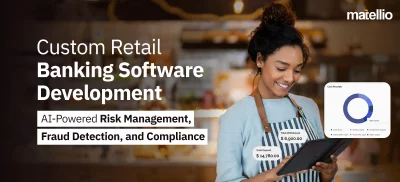
IoT has been breaking headlines for a long time now. Although not one of the early adopters, the banking industry is leveraging IoT’s potential to revolutionize its processes. Studies have indicated that the BFSI market is expected to leap from USD 249.4 million in 2018 to USD 2,030 million by 2023, at a CAGR of 52.1%.
Certainly, IoT is driving a new age of banking and finance services. Business decisions are data-driven, customers enjoy less waiting time in queues, and most importantly, the monotonous jobs are taken care of. But that’s not it. Let’s get into the details of IoT implementation in banks in the following few minutes.
How can IoT Help Banking Industry Grow?
1. Data-driven Analytics
Data has been changing how banks work. The finance and banking industry is not building a strong foundation for itself using data and switching the paradigms of its operations. Here is how data is reinventing banking:
a. Enhanced Customer Experience
As soon as customer logs in to their banking systems, they see the same range of things. They’ll get a glimpse into their accounts, how much funds they have, their investment portfolio, etc. However, this makes the banking experience more monotonous and less lucrative for the banks. Banks can use this space to show their customers what they look for when they are in their accounts. They can also track what banking and financial services their customers are looking for and entice them with tailored marketing strategies.
b. Business Growth
Data serves as a backbone for informed decision-making. For instance, imagine one of your branches is not receiving as much traffic as it is supposed to. Customers are nearby, the location is prime, facilities are state-of-the-art, and your staff is doing everything. The process of actually figuring out why customers aren’t visiting is baffling.
Having data at your fingertips can help you determine the how’s and why’s under these situations and strategize better. Maybe the customers in this specific area prefer digital banking options, or perhaps, many residents are stuck by flu season and unable to visit the branch. This helps you understand where to invest and what solutions you can offer to these customers.
c. Risk Management
Proactive risk management is a must-have for the banking and finance industry. Banking institutions work in a dynamic operating environment marked by changing customer demands, evolving economy, widening scope and intensity of the industry regulations, and challenging technological innovation. Without a proper risk management system, a bank gradually loses its market share and eventually fails.
IoT in banking and finance helps these organizations devise the right system. The data collected by the IoT-based banking solutions minimize risk exposure by measuring, monitoring, and eliminating potential threats in day-to-day operations. This helps significantly control the adverse outcomes and boosts the likelihood of further development.
d. Understand and Identify Growth Opportunities
Real-time data is the best source for understanding the market demands and pinpointing growth areas. For instance, if a location mostly comprises millennials, there are more chances of your customers interacting with you via banking applications than the physical branch. Similarly, if your customers are more active on the phone at a specific hour of the day, your marketing notifications are more likely to bring conversion.
This certainly gives you a clear picture of the gaps in your operations that you can fill for maximum results.
e. Personalized Services
Personalization is demanded in every industry today. It not just adds value to the customer experience but also increases your chances of conversions. Customer-related data includes information on clients’ needs, economic conditions, buying behavior, etc. Helps you tailor your marketing strategies. You can also track your customers’ activities and offer them the solution that they require at the right time.
2. Secure Payments
Security is an important aspect of the banking industry. While in-branch security is vital to assets, securing payment procedures is a must-have to meet consumers’ changing demands.
Thankfully, IoT in banking takes care of both. Smart CCTV cameras, surveillance systems, and alarm systems can help banks monitor the vicinity. These systems carefully collect data and match patterns. Anytime there is a potential security threat, these systems can alert the authorities and even contact the police. Similarly, smart payment methods encrypt the transaction details, ensuring secure payments. IoT in banking also collects data to identify the patterns of potential frauds. Anytime a similar series of actions are detected, the system would alert the authorities.
3. Improved Transparency
IoT in banking drives a high level of transparency. Lenders can collect detailed information about the customers. This helps them distinguish unreliable debtors from the crowd and make informed credit decisions. Banks can also know about their customer’s behavior, motivators, and credit records to personalize services.
4. Better Services Range
IoT liberated banking from being a four-walled experience. It helps customers track their spending behavior, income statistics, savings records, etc. Customers can seamlessly know the status of their turn on the counter and arrive as and when they need to be there. Similarly, banks can track customers’ visiting history, know what services they are looking for, etc.
IoT in banking also gives a boost to the traditional banking paradigms. For instance, they can connect with the consumer’s wearable devices and track their health status. It can also prove itself as a futuristic brand by motivating positive fitness habits and rewarding the customers when they meet certain goals.
Read More: Top 10 Core Banking Solutions
5. Transform Branch Banking for Better
Mobile banking has taken the industry by storm. Traditional banking systems need to upgrade themselves in order to stay relevant. IoT in banks allows put state-of-the-art biometric sensors in place that alerts the employees as soon as the person enters banks.
These systems are smart branches and offer an intuitive banking experience to the customers. An example is how BMO Harris Bank created a smart branch across some locations. They smartly used digital and physical touchpoints to enhance customer experience by offering:
- ATMs with Mobile Cash withdrawal options without using Debit Cards,
- Liberty for customers to choose money denominations during withdrawals
- State-of-the-art digital infrastructure for bankers to assist customers with new banking technology
- Public WiFi access for customers to use mobile banking
6. Process Automation
Business process automation is a much-in-demand aspect, regardless of your industry. Banking and financial organizations need to gear up for the challenges of the tech-savvy world. They need to optimize the cost of operation and ensure high efficiency. At the same time, they also need to curb the scarcity of skilled resources, decrease personnel costs, and improve the quality of processes.
The introduction of IoT in banks can drastically solve this problem with process automation. It allows banks to decrease manual efforts, offer better compliance, mitigate risks, and enhance the customer experience. Here is how IoT-powered process automation fits into the banking operations:
7. Real-time Monitoring
Real-time monitoring helps banking institutions to improve the quality of their services. For instance, IoT-based monitoring systems can help banks track the number of people at any specific time. They can send regular alerts if the number goes above a threshold value or if customers have to wait long in a line.
Banks can use this to take measures to avoid such situations.
Also Read- Financial Software Development: A Complete Guide for Businesses
How to Leverage IoT in Your Banking and Finance Organization?
IoT in banking certainly has a lot of potential. All you need to do is find out how it fits your requirements. For instance, if you want to analyze data for strategic decisions, you want to build data collection and analytics tools. However, if your needs are related to smart banking and ATM solutions, the process will also include hardware development.
1. Understand if your Business is Ready for IoT and Identify the KPIs
The first step is to dig deep into your business processes and identify the gaps that IoT can fill. You also need to ensure that you have listed all the KPIs on which you will judge the progress of your banking industry digital transformation initiative.
Having a team of business technology consultants can certainly help you with this. Not only do they help you uncover the hidden potential of your idea. If you have invested in data analytics, you might also need to have the right system in place for data management. Here are a few questions you might need to answer.
How is your IoT development team managing the data?
IoT development comes with a lot of data, which only grows with time. Your development teams need to ensure that the data is well handled and managed. Any breach in data might have dire consequences for your business and its reputation.
Is your security infrastructure ready for new challenges?
The higher the number of devices, the higher the entry points of hackers. This puts you at risk of data theft. To avoid this, you need to ensure your data is secured by advanced security solutions like encryption, blockchain, cybersecurity, frameworks, etc.
How will you integrate existing banking ERPs with the new solutions?
Your IoT app development company must follow standardized processes and industry guidelines. The IoT system should be extensible to the existing banking ERP solutions.
Our IoT consultation experts can help you here. With our experience in delivering banking software for global finance organizations, they hold the right technology insight and understanding. Their expertise can help you create the right IoT implementation strategy and follow it for maximum value.
2. Shortlist an Education IoT App Development Company
The next step is to hire an IoT development company for your IoT banking solution. Check for these factors while shortlisting them:
- Their experience and expertise for IoT in banking as well as IoT development in general
- Quality of IoT development services they offer
- Rating from recent clients
- Overview and expertise of their IoT projects
- Additional USPs in IoT development
3. Start IoT Development
Once you have the right technology partner by your side, you can start with IoT development for your banking or finance organization. While there can be many processes being followed, here is what gives our customers results:
- Discovery of all the IoT development requirements for your bank
- SRS creation with scope freezing
- UI/ UX development
- Hardware/ software development
- QA and testing
- Bug fixes
- Deployment
Are You Ready to Implement IoT in Your Bank?
The future of banking is built on the foundation of IoT. With the growing number of devices, the role of IoT in banking will only gain t deeper impact. To stay ahead of the competition, it is important for banking and finance institutions to invest in IoT development to revolutionize the processes.
Matellio has been chosen by 100s of brands for cutting-edge technology transformation. Our well-rounded agile development process enables businesses to address their organizational challenges with the right technology solutions smoothly. Our IoT capabilities include:
- Specialized IoT Teams
- Vast industry experience with IoT products
- Handon experience in the futuristic technology stack
- Secure data management
- Management for legacy and advanced devices
- High-performance data streaming and analytics
To begin with IoT development right away, request a free quote.









